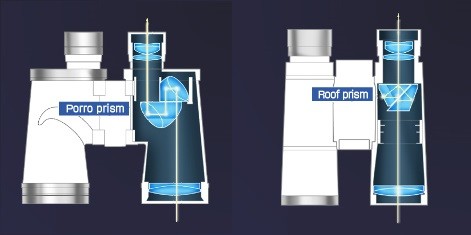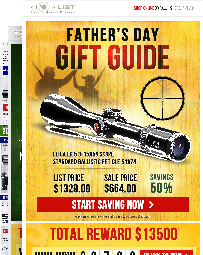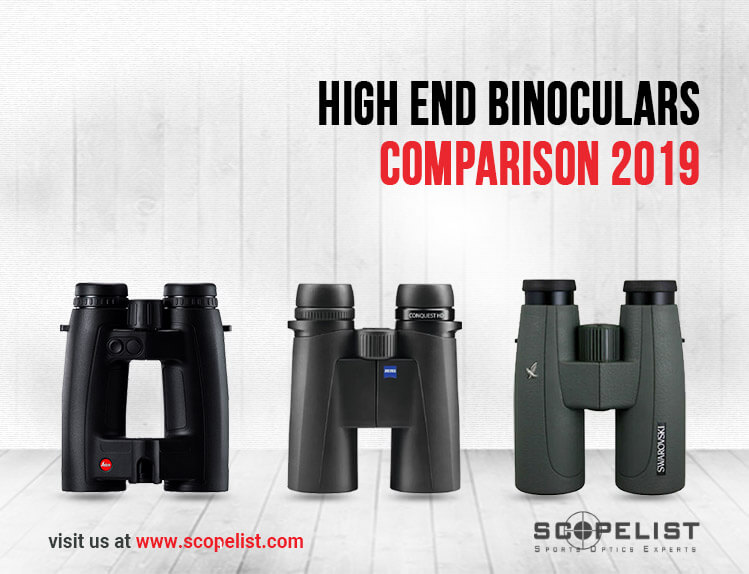Table of Contents
- Introduction
- Best Leica Binoculars for Hunting 2019
- Best Leica Binoculars for Birding 2019
- Leica Trinovid HD vs Zeiss Conquest HD vs Swarovski SLC
- FAQs
- Conclusion
Introduction
Leica is known for producing some of the finest quality optical devices in the world. They manufacture their binoculars under Leica Camera AG in Germany, which also has another base in Portugal. The extensive line of Leica binoculars come with optical superiority as well as structural reliability. Whether you are looking for a binocular for birdwatching, experiencing nature, or hunting, Leica Optics has the perfect binocular for you.
The best thing about Leica binoculars is that they don’t compromise on durability, balance, performance, weight, and size. The high-quality optics used in the Leica binoculars provide users with unsurpassed image sharpness, image definition, color rendition, and optical clarity. That’s why these binos don’t come at cheap prices. The “no-fault” lifetime warranty from Leica and uncompromised quality make these binos that more popular among hunters and birders despite their comparatively higher prices.
Top 7 Best Leica Binoculars
- Leica Laser Rangefinding Binoculars
- Leica Geovid HD-B 3000 Rangefinding Binoculars: $2,949-$3,299
- Leica Geovid HD-R 2700 Rangefinding Binoculars: $2,549-$2,899
- Leica Trinovid Binoculars: $429-$999
- Leica Noctivid Binoculars: $2,699-$2,849
- Leica Ultravid HD Binoculars: $749-$899
- Leica Ultravid HD-Plus Binoculars: $1,999-$2,549
- Leica Duovid Binoculars: $2,599-$2,799
Now, let’s have a look at the top 3 best Leica binoculars for hunting and bird watching/nature viewing.
Best Leica Binoculars for Hunting 2019
11 Factors to Check for Choosing a Hunting Binocular
Choosing a hunting binocular depends upon a number of factors. Let’s have a look:
Magnification
Though bigger magnification (say, 12x, 15x, or even 20x) may be tempting, 7x to 10x magnification is more than enough in the case of hunting. The higher the magnification, the extent of image steadiness is lower. It will take a while to get a steady view at higher magnification. In the case of hunting, you’ll hardly want to steady a heavy bino having a magnification larger than 10x. If you want a higher magnification optical device to look at extreme long-range distances (say, 15x, 20, etc.), you should probably go for a spotting scope instead of a binocular, or consider using a tripod or other mount system.
Front/Objective Lens Size
The larger the objective diameter of a binocular, the hunter gets to view greater details. If your binocular comes with a 40mm or 42mm objective lens diameter, you can use it with any type of hunting, especially during legal hunting hours. If you prefer hunting during twilight (the prime time when the games come out of the woods), go for a binocular having a 50mm objective lens. Some hunters also prefer using a bino having 32mm or 30mm objective diameter for lighter weight and enhanced portability. However, any binocular having less than 30mm objective lens diameter is not suitable for hunting in low light conditions.
Field of View
This is important because it tells you the field area that you can view at a distance of 1000 yards. That’s why it is expressed as FOV at 1000 yards. Higher FOV means a wider open area that can be viewed through a bino. If you are targeting a fast-moving game, you don’t really need to have a higher field of view. In most hunting cases, a standard FOV is enough for your binocular.
Exit Pupil
When you divide the objective lens diameter by magnification factor, you get the eye relief. You’ll get a 5.25 mm eye relief when you divide the 42mm objective lens diameter by 8x magnification factor of a binocular. The eye pupil is capable of dilating up to 7mm in the case of young people and up to 4mm in the elderly. As a thumb rule in hunting, try choosing a binocular having an exit pupil equal or larger in size than that in your eye.
Type of Prism Used
There are two main types of prisms: porro prisms and roof prisms. The roof prism design makes the binos lightweight and slimmer than that of porro prism binos. However, the roof prism binoculars are costlier.

Types of Focus
Binoculars usually have two types of focus: individual eyepiece focus and center focus. Individual focus binoculars work excellently in the medium-to-long-range-distances, especially beyond 30-40 yards. The central focus binos are best for locating games at closer ranges, especially within 30 yards.
Eye Relief
Generally, binos come with 14-20 mm eye relief. It is the crucial distance from which the binocular can be held for getting the entire image of the target. It is especially important for users who wear eyeglasses or prefer wearing sunglasses. The users wearing glasses should choose a bino having an eye relief that is at least 14-15 mm. This can’t be compromised because it can reduce the field of view.
Optical Coating
The optical coating on binocular’s glass surface of the objective lens help in eliminating or reducing light reflection. Try choosing a bino coming with the multi-coated lens because it reduces light reflection more effectively than a single layer coating, thereby increasing the transmittance of light.
Image Quality
A binocular should have an excellent image quality because it helps in distinguishing whether you are looking at a deer or a rock. Though it is tricky to choose a high-quality image binocular, you may try buying the ones manufactured by Leica, Zeiss, Swarovski, Nikon, Vortex, and many more.
Size and Weight Matter Too
Hunters usually look for binos that are compact and lightweight so that it is easier for them to carry around their necks. These lightweight and compact binos usually come with 30 mm, 32 mm, or lesser diameter objective lenses. Though they don’t provide the best performance, these binos are best for hunting expeditions that require lots of hiking.
Some of the best compact Leica binoculars are:
- 32 mm Objective Lens Compact Binocular
- 25 mm Objective Lens Compact Binocular
- 20 mm Objective Lens Compact Binocular
Rubber Coating and Waterproofness
The rubber coating is especially essential for hunting binoculars because it provides a better grip of the optical device, even in wet conditions. Waterproofness of their binos is also very important for hunters because that helps them view games even in rainy weather.
These are the 11 factors that you should consider while buying a Leica binocular.
Top 3 Best Leica Binoculars for Hunting 2019
Leica Geovid HD-B 3000
It is definitely one of the best mid-sized binoculars available in the market. The updated 2019 version of Leica Geovid HD-B Binocular comes with a faster and more powerful laser that can reach up to 3,000 yards. It comes in both 8x and 10 magnification. Other important aspects are an excellent resolution, amazing low-light capability, ballistics calculator having up to 12 standard loads profile, Perger Porro prism, and very comfortable balance.
Leica Geovid HD-R Waterproof Binoculars, yard version
These binoculars are best for hunting on mountainous or low-visibility terrain. The newer and updated version of Geovid HD-R comes with EHR (Equivalent Horizontal Range), innovative ballistic function, comfortable eye relief for observing for a longer period of time, large field of view (374 ft /114 m), razor-sharp images, brilliant color fidelity, classic ergonomic & intuitive design.
Leica Trinovid HD Binoculars: Perfect All-Rounder
Leica Trinovid is a perfect all-rounder binocular that can be used for all purposes including hunting, bird watching, experiencing nature, and many more.
The new Leica Trinovid-HD 42 models come with compact design, have high impact resistance, commendable durability, ruggedness, image performance & sharpness, outstanding color fidelity, almost indestructible construction, uncompromising resolution power, ergonomic design, and absolutely precise focusing.
Comparison: Leica 10×42 Geovid HD-B vs. Leica 10×42 Geovid HD-R vs. Leica Trinovid HD 10×42
| Specifications | Leica 10×42 Geovid HD-B | Leica 10x42 Geovid HD-R 2700 | Leica Trinovid HD 10x42 |
|---|---|---|---|
| Magnification | 10x | 10x | 10x |
| Front Lens Diameter | 42 mm | 42 mm | 42 mm |
| Field of View | 374 ft at 1000 yards (124 m at 1000 m) | 374 ft at 1000 yards (124 m at 1000 m) | 339 ft at 1000 yds (113 m at 1000 m) |
| Exit Pupil | 4.2 mm | 4.2 mm | 4.2 mm |
| Twilight Factor | 20.5 | 20.5 | 20.5 |
| Price (MSRP) | $2499 | $2,599 | $899 |
| MPNs | 40444 40801 |
40804 | 40319 |
Best Leica Binoculars for Birding 2019
Explore nature, its beauty, and wide-array of birds in different parts of the world with the best Leica binoculars.
Top 5 Tips to Buy the Best Bird Watching Binocular
Decide the Budget you want to Spend on a Binocular for Birding and Nature Gazing
Binoculars come in 5 categories of the price range:
- Premium or top-of-the-line binoculars (above $2,000)
- High-end binoculars ($1.000-2,000)
- Upper-mid-range binoculars ($500-1,000)
- Lower-mid-range binoculars ($300-500)
- Good value binoculars ($150-300)
Always set your priorities right. You have to decide the budget in which you want to buy the binocular. Only after deciding this factor, check the other features.
Magnification Matters
The birding Binoculars usually come in two magnifications: 8x and 10x.
- The 10x binos are better for viewing at long-range distances. However, they come with a narrower field of view and slightly darker image in low light conditions.
- The 8x binos are better for tracking, finding, and following birds. They provide you with a smaller image but also with a wider and brighter one.
Choose a Bino providing Brighter, Crisper, and Truer Color
While choosing a binocular always keep in mind that watching birds, especially in forests, don’t always provide you with adequate light. So, always go for a high-quality optics that provides you with a clearer, crisper, brighter, sharper, and higher quality image. Try to choose a birding binocular in the budget that lets you get better images even at low light conditions.
Check the Eye Relief
Larger eye relief in a bird-watching binocular is always desirable because that helps a birder watch through the binocular even with his eyeglasses or sunglasses on. Most binos nowadays come with eyecups. In that case, go for the ones that are multi-adjustable and durable. For ensuring enough eye-relief, It is better to adjust the eyecups to their minimum position.
Check other Features & Warranties
Field-of-view (FOV) and close focus are extremely important. Try to choose a bino that provides you wider FoV and closer focus capability. Always check the warranty facilities that you’ll get with the binocular.
Some of the Leica binocular warranties that a buyer can enjoy are no-fault 3 Year Passport Warranty, a Lifetime Limited Warranty, and Passport Warranty (no-fault coverage ensures that Leica will repair a binocular free of charge if you break the device).
Top 3 Best Leica Binoculars for Birding 2019
Leica Ultravid HD-Plus Binoculars
These are a one-step ahead of the already highly respected line of Ultravid HD binoculars. Leica has upgraded both the prism glass and coatings in the Leica Ultravid HD-Plus Binoculars by keeping the ergonomics and outer form the same. These binos come with the innovative AQUADURA coating (protecting the optical systems from dirt, water, and damage), and crystal-clear vision.
Leica Ultravid HD-Plus Models:
- 50mm Objective Lens
Leica Ultravid 12x50mm HD-Plus 40097
Leica Ultravid 10x50mm HD-Plus 40096
Leica Ultravid 8x50mm HD-Plus 40095
- 42mm Objective Lens
Leica Ultravid 10×42 HD-Plus 40094
Leica Ultravid 8×42 HD-Plus 40093
Leica Ultravid 7×42 HD-Plus 40092
- 32mm Objective Lens
Leica Ultravid 8x32mm HD-Plus 40090
Leica Ultravid 10x32mm HD-Plus 40091
Leica Noctivid Binoculars
These are the premium-range binoculars that come with compact dimensions as well as elegant/stylish design. The incredibly robust and resilient Leica Noctivid Binoculars offer you perfect balance, brilliant/sharp images, high contrast, large depth of field, generous eyepieces, and short overall length. Noctivid line of binoculars provides you with fatigue-free viewing for longer hours.
Leica Noctivid Binocular Models:
10x Magnification:
Leica Noctivid 10×42 Binocular 40385
Leica Noctivid 10×42 Green Binocular 40387
8x Magnification:
Leica Noctivid 8×42 Green Binocular 40386
Leica Noctivid 8×42 Binocular 40384
Leica Duovid Binoculars
Leica Duovids are also premium-range binoculars that have the unique capability of switching between discreet magnifications. They come in two variants: the versatile Leica Duovid 8+12×42 binoculars and magnanimous Leica Duovid 10+15×50 binoculars (also capable for astronomical observation).
Comparison: Leica 10×42 Geovid HD-B vs. Leica 10×42 Geovid HD-R vs. Leica Trinovid HD 10×42
| Specifications | Leica Ultravid HD-Plus 10x42 | Leica Noctivid 10x42 | Leica Duovid 10+15x50 |
|---|---|---|---|
| Magnification | 10x | 10x | 10+15x |
| Front Lens Diameter | 42mm | 42mm | 50mm |
| Field of View | 337.35 ft at 1,000 yards (112 m at 1,000 m) | 337.3 ft at 1,000 yards (112 m at 1,000 m) | 10x: 274 ft at 1,000 yards
(90.97 m at 1,000 m) 15x: 208 ft at 1,000 yards (69.06 m at 1,000 m) |
| Exit Pupil | 4.2 mm | 4.2 mm | 10x: 5 mm 15x: 3.3 mm |
| Twilight Factor | 20.5 | 20.5 | 10x: 22.36 15x: 27.39 |
| Price (MSRP) | $2,299 | $2,799.00 | $2,799.00 |
| MPNs | 40094 | 40385 40387 |
40420 |
Leica Trinovid HD vs Zeiss Conquest HD vs Swarovski SLC
Leica Trinovid 10×42 Binocular provides its users with a sturdy design, 90% light transmission, amazing ergonomics, and full waterproofing & fog-proofing features. This versatile bino is a premium optical device (coming at a price of more than $2,500) that can be used for both hunting and birding.
Swarovski SLC is also a high-end binocular that comes at a price of over-$1,500. It is also an all rounder and can easily be compared with that of Leica Trinovid Binoculars. These binoculars come with excellent ergonomics, HD optical system, lightweight magnesium housing, 3-position eyecups, Monochrome Rubber Armoring, and many more features. If you already possess Leica Trinovid 10×42, it would not be prudent to replace it with Swarovski SLC 10×42 WB HD Binocular. If you are looking for an alternative to Trinovid, you can definitely try out Swarovski EL 10×42 Binoculars.
Zeiss Conquest HD 10×42 Binocular comes with razor-sharp image, 92% light transmission, precise focus, comfortable eye-relief, and advanced LotuTec water-shedding outer coating. These binos come at a $1,000 price range, making them more desirable to users. These binoculars are the leading most names in their class (the high-range binos). They don’t belong to the premium class binoculars such as Leica Trinovid or Swarovski SLC. However, their price gives Conquest HD an edge over these premium-class binos.
FAQs
FAQ #1 What is the difference between Leica Trinovid and Ultravid binoculars?
Leica Ultravid binoculars come with a highly reflective prism/mirror coating in addition to the high degree of Leica lens multi-coating that you find in Leica Trinovid binoculars. While Ultravids come with a lightweight magnesium body, Trinovids come with aluminum body. The Leica Ultravid Binos are brighter too.
FAQ#2 Where are Leica binoculars manufactured?
They are built in Germany’s Leica Camera AG facility. Their other base is located in Portugal.
FAQ #3 How long is Leica Binocular Warranty?
The warranty period for Leica binoculars varies from 1 year to 10 years. While most Leica Binoculars come with 10 years warranty, Geovid Binoculars come with 5 years warranty.
Conclusion
Leica has been manufacturing binoculars for hunters, bird watchers, nature lovers, and outdoor enthusiasts for more than a century now. They have not only maneuvered through the tide in these 100 years but also adopted the latest technology to provide their customers with the highest quality products at the competitive price range. If you are looking for a high-end device to get the best of views, go with Leica Geovid, Noctivid, and Ultravid HD-Plus Binoculars. In case you have a budget constraint, try the Leica Trinovid Binoculars at under-$1,000. You’ll not regret after buying any of these Leica Binoculars.




